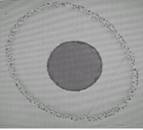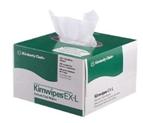Fiber optic cleaning - fiber connector cleaner
Why do we need fiber optic cleaning?
Fiber optic cabling has become telecommunication backbone of today’s university campuses and enterprises. With the prosperity of Gigabit Ethernet and 10 Gigabit Ethernet, ensuring clean fiber optic connections has become one of the most critical requirements for maintaining error-free communication in these fiber optic communication systems.
Repeated fiber optic connector disconnection and reconnection often leaves debris in the bulkhead adapter or receptacle. With single mode fiber core as small as 9 micrometer, even a single 1 micrometer dust particle can cause a big signal loss or even interrupt the communication, if left blocking the fiber core.
Here are some samples pictures showing optical connector contaminations.

Fiber optic connector with dust

Fiber optic connector with liquid (solvent residue) contamination

Fiber optic connector with dry residue
Optical Connector Cleaning
Basically there are two types of fiber optic connector applications that need cleaning.
- Free connectors on a fiber optic patch cable or fiber pigtail
- Connectors plugged in patch panels or other hardware devices and equipment.
We will describe the products suitable for each application later in this article.
Fiber Optic Cleaning Methods
Fiber optic cleaning kit on the market can be divided to four types based on the cleaning method.
- Dry cleaning: Optic cleaning without the use of any solvent.
- Wet cleaning: Optic cleaning with a solvent. Typically IPA (isopropyl alcohol).
- Non-Abrasive cleaning: Cleaning without abrasive material touching the fiber optic connector end face. Examples are air dusters or pressured solvent jet used in automated in-situ connector cleaners.
- Abrasive cleaning: The popular lint free wipes, reel based Cletop fiber connector cleaners and optic cleaning swabs such as the Cletop sticks are all abrasive cleaning types.
Dry cleaning products
Air spray (air duster, canned air, compressed air) – Air dusters are used to blow loose particles from optical fiber connector endface, or dry up solvent (isopropyl alcohol) residue after a wet cleaning.
All air dusters are not the same. Optic grade is more expensive. Air spray is a non-abrasive fiber optic cleaning method.
Lint free wipes – The traditional way of fiber optic cleaning is to use lens paper or cloth to clean the optical fiber connector endface.
The operator folds the lens paper (such as the lint free wipes) into 4~6 layers and lay it flat on a table. He then holds the connector vertically straight and cleans the end face in figure 8 motion.
This fiber optic cleaning method is inherently abrasive and sometimes can induce scratches. This dry cleaning step is also necessary after a wet cleaning to remove solvent residue.

Lint-free wipe cleaning method
Reel based Fiber Connector Cleaner - Cletop and Optipop are the two most popular brands for reel connector cleaners. Connector reel cleaner is a dry cleaning method with a quick, reliable operation and uniform results. They use 2 micrometer weaved polyester cloth to clean optical fiber connectors.
One reel cleaner tape may be used for over 400 cleanings. Additional replacement tapes are available and allow continued use of the outer case.
This is an abrasive fiber optic cleaning method but pad underneath cleaning cloth mitigates this significantly.

The structure of a Cletop Reel Connector Cleaner

Cletop connector reel cleaner in action

Cletop-S reel cleaner with replacement tapes
Cletop stick – These specially built Cletop sticks come in 2.5mm and 1.25mm versions. They are designed for dry cleaning fiber optic connector mating sleeves, bulkhead adapters and receptacles.
To clean the endface of connectors already installed in patch panels and hardware devices, you insert the Cletop stick into the bulkhead adapter or receptacle, make the tip contact the connector endface, make a single turn and then pull the stick out and dispose. You should never reuse a Cletop stick.
This is an abrasive fiber optic cleaning method but a resilient stick head mitigates this.

Cletop Stick (both 2.5mm and 1.25mm versions available)

Cleaning fiber optic bulkhead adapter

Cleaning a fiber optic receptacle on fiber devices
In-situ cleaning – This semi-automated fiber optic cleaning method is specially designed for fiber optic connectors plugged in patch panels and hardware devices.
It’s more like an automated Cletop stick. Seiko Geiken’s Ferrule Mate is a very popular brand of this type of fiber connector cleaner. They can be used on PC and APC (angled) polished connectors. Both 1.25mm and 2.5mm versions are available.

Ferrule Mate for in adapter connector cleaning
Features
- Polyester static free cloth for optimal cleaning
- 350 swipes per cleaner (1 swipe per cleaning)
- Cleaning tip adjustable to 45 degrees for angled adapters
- Spring-loaded tip for controlled cleaning pressure
- For PC and APC types
- Ideal for cleaning transceiver ports
- New, heavy duty tip
Wet Cleaning Products
Alcohol with lint-free wipes: This is the traditional way of fiber optic wet cleaning. A few drops of solvent (typically isopropyl alcohol) are applied to lens paper which is folded in 4~6 layers and laying flat on the table. The operator then holds the connector vertically and cleans it in figure 8 motion. This must be followed by a dry cleaning step to prevent solvent residue, either by air duster or dry lint-free wipes.
Pre-saturated or soaked wipes – wet cleaning. Pre-saturated wipes are good for cleaning glass fiber or connector end faces. They are available in a convenient pre-saturated towelette. The towels are durable and non-linting. Pre-saturated wipes are a convenient option for field use.
The three critical steps of fiber optic connector cleaning
Reminders
- Never touch the end face of an optical fiber connector
- Always Install dust caps on unplugged fiber connectors
- Store unused dust caps in a re-sealable bag to prevent dust accumulating
- Do not re-use optic cleaning swabs or lens paper (lint free wipes)
- Make sure all solvent residues are removed when using a wet cleaning
- Do not clean bulkhead receptacles without a means of inspection following the cleaning. The attempted cleaning could easily make the condition worse







